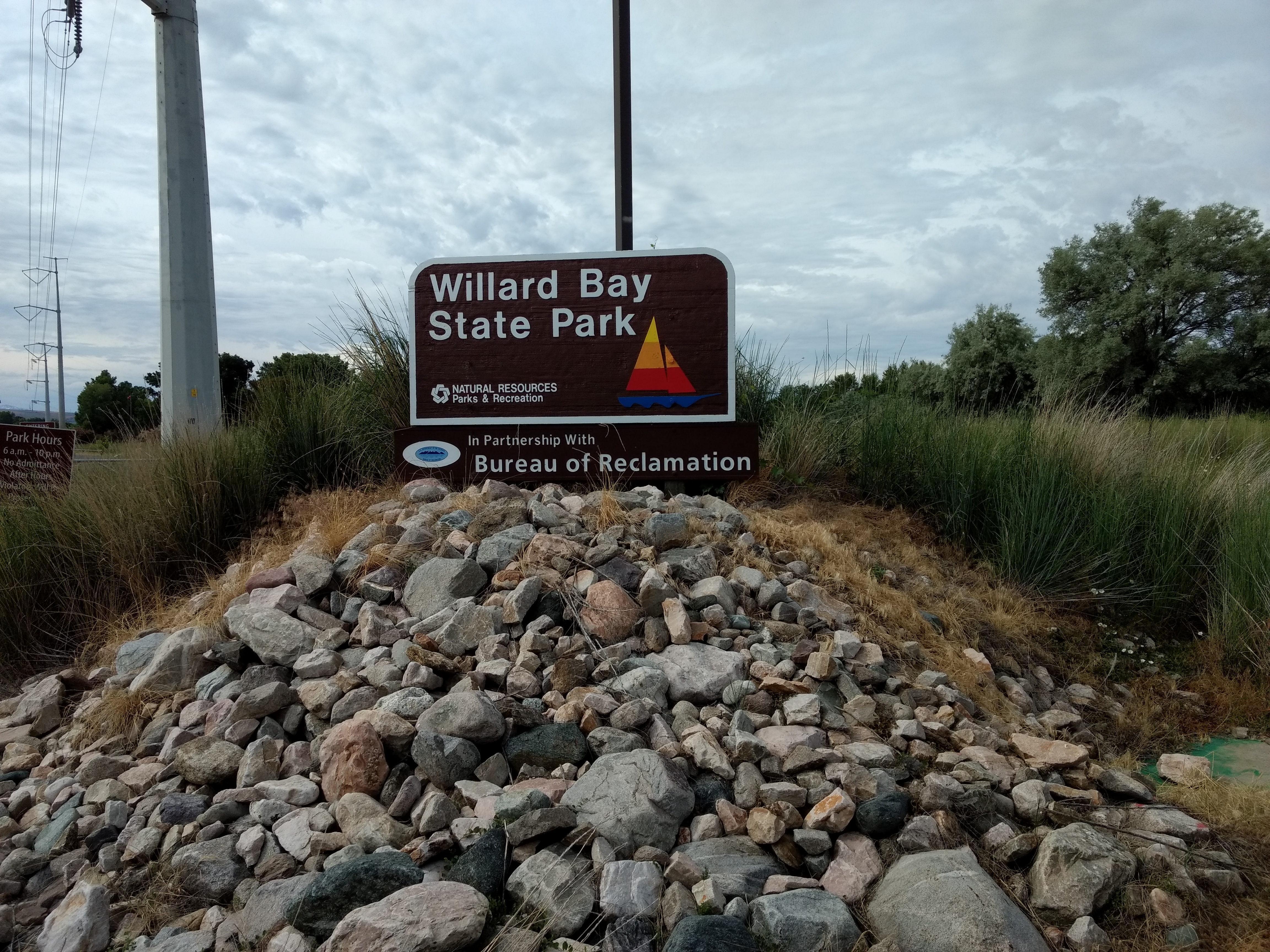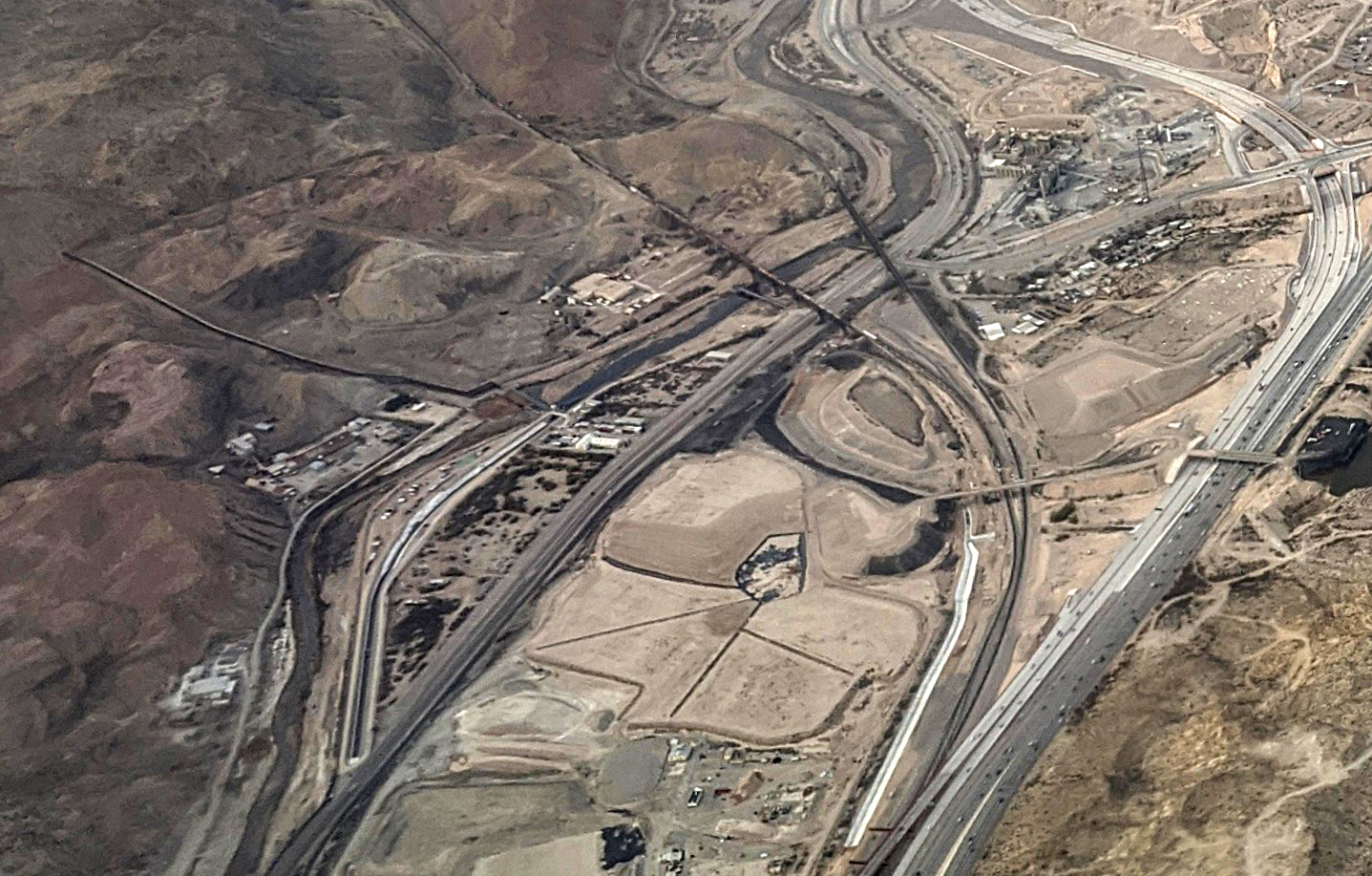|
Riverside Diversion Dam
The Riverside Diversion Dam (or simply the Riverside Dam) was a diversion dam on the Rio Grande to the southeast of El Paso, Texas. The dam was owned by the United States Bureau of Reclamation, and diverted water into the Riverside Canal for use in irrigation in the El Paso Valley. The dam became obsolete with completion of a cement-lined canal carrying water from the upstream American Diversion Dam to the head of the canal. It was partially removed in 2003. Construction The 21 May 1906 treaty between the United States and Mexico for "an equitable distribution of the waters of the Rio Grande" guaranteed Mexico up to annually, with the Americans taking the rest, except in time of drought when the shares would be reduced on a percentage basis. The Mexicans would withdraw their water from the Rio Grande at the Acequia Madre about downstream from the point where the river starts to form the international border. Riverside Diversion Dam was the lowermost dam of the Rio Grande Pro ... [...More Info...] [...Related Items...] OR: [Wikipedia] [Google] [Baidu] |
El Paso, Texas
El Paso (; "the pass") is a city in and the seat of El Paso County in the western corner of the U.S. state of Texas. The 2020 population of the city from the U.S. Census Bureau was 678,815, making it the 23rd-largest city in the U.S., the sixth-largest city in Texas, and the second-largest city in the Southwestern United States behind Phoenix, Arizona. The city is also the second-largest majority-Hispanic city in the U.S., with 81% of its population being Hispanic. Its metropolitan statistical area covers all of El Paso and Hudspeth counties in Texas, and had a population of 868,859 in 2020. El Paso has consistently been ranked as one of the safest large cities in America. El Paso stands on the Rio Grande across the Mexico–United States border from Ciudad Juárez, the most-populous city in the Mexican state of Chihuahua with over 1.5 million people. The Las Cruces area, in the neighboring U.S. state of New Mexico, has a population of 219,561. On the U.S. side, th ... [...More Info...] [...Related Items...] OR: [Wikipedia] [Google] [Baidu] |
Rio Grande
The Rio Grande ( and ), known in Mexico as the Río Bravo del Norte or simply the Río Bravo, is one of the principal rivers (along with the Colorado River) in the southwestern United States and in northern Mexico. The length of the Rio Grande is . It originates in south-central Colorado, in the United States, and flows to the Gulf of Mexico. The Rio Grande drainage basin (watershed) has an area of ; however, the endorheic basins that are adjacent to and within the greater drainage basin of the Rio Grande increase the total drainage-basin area to . The Rio Grande with its fertile valley, along with its tributaries, is a vital watersource for seven US and Mexican states, and flows primarily through arid and semi-arid lands. After traversing the length of New Mexico, the Rio Grande becomes the Mexico–United States border, between the U.S. state of Texas and the northern Mexican states of Chihuahua and Coahuila, Nuevo León and Tamaulipas; a short segment of the Rio ... [...More Info...] [...Related Items...] OR: [Wikipedia] [Google] [Baidu] |
United States Bureau Of Reclamation
The Bureau of Reclamation, and formerly the United States Reclamation Service, is a federal agency under the U.S. Department of the Interior, which oversees water resource management, specifically as it applies to the oversight and operation of the diversion, delivery, and storage projects that it has built throughout the western United States for irrigation, water supply, and attendant hydroelectric power generation. Currently the Bureau of Reclamation is the largest wholesaler of water in the country, bringing water to more than 31 million people, and providing one in five Western farmers with irrigation water for 10 million acres of farmland, which produce 60% of the nation's vegetables and 25% of its fruits and nuts. The Bureau of Reclamation is also the second largest producer of hydroelectric power in the western United States. On June 17, 1902, in accordance with the Reclamation Act, Secretary of the Interior Ethan Allen Hitchcock established the U.S. Reclamat ... [...More Info...] [...Related Items...] OR: [Wikipedia] [Google] [Baidu] |
Riverside Canal (El Paso)
The Riverside Canal is an irrigation canal in El Paso County beginning southeast of El Paso, Texas. The canal acquires water from the Riverside Diversion Dam on the Rio Grande The Rio Grande ( and ), known in Mexico as the Río Bravo del Norte or simply the Río Bravo, is one of the principal rivers (along with the Colorado River) in the southwestern United States and in northern Mexico. The length of the Rio G ... southeast of El Paso. The canal is managed by the US Bureau of Reclamation. The canal extends for with a capacity of 900 cubic feet per second. Water from the canal irrigates about 39,000 acres (160 km2). The canal and diversion dam is the southernmost system on an irrigation project extending along the Rio Grande in New Mexico and Texas. The canal supplies a canal network extending throughout the Upper Rio Grande Valley. See also * American Canal * Franklin Canal (Texas) * Texas Irrigation Canals * United States Bureau of Reclamation External ... [...More Info...] [...Related Items...] OR: [Wikipedia] [Google] [Baidu] |
American Diversion Dam
The American Dam, or American Diversion Dam, is a diversion dam on the Rio Grande in El Paso, Texas, that divides the river water between Mexico and the U.S. It is about north of the point where the west bank of the river enters Mexico, from the business center. The dam is operated by the International Boundary and Water Commission. It started operation in 1938. Origins The dam has its origins in the 21 May 1906 treaty between the United States and Mexico for "an equitable distribution of the waters of the Rio Grande." This guaranteed Mexico up to annually, with the Americans taking the rest, except in time of drought when the shares would be reduced on a percentage basis. The Mexicans would withdraw their water from the Rio Grande at the Acequia Madre in Ciudad Juárez about downstream from the point where the river starts to form the international border. To ensure that they got their agreed share, in 1935 Congress authorized construction of the American Dam, which mea ... [...More Info...] [...Related Items...] OR: [Wikipedia] [Google] [Baidu] |
American Canal
The American Canal is an irrigation canal in the Upper Rio Grande Valley near El Paso, Texas. The canal acquires water from the Rio Grande The Rio Grande ( and ), known in Mexico as the Río Bravo del Norte or simply the Río Bravo, is one of the principal rivers (along with the Colorado River) in the southwestern United States and in northern Mexico. The length of the Rio ... from the American Diversion Dam at the Texas–New Mexico–Mexico border, northwest of downtown El Paso. The canal supplies the majority of the raw water to El Paso’s Johnathan-Roger Water Treatment Plant. It also mitigates flooding in south El Paso neighborhoods. The canal travels along the Rio Grande for where it flows into the Franklin Canal and the rest of the canal network. Construction of the canal dates back to 1938. See also * Texas Irrigation Canals * Franklin Canal (Texas) * Riverside Canal References {{Coord, 31.7724, -106.5153, type:river_region:US-TX, displ ... [...More Info...] [...Related Items...] OR: [Wikipedia] [Google] [Baidu] |
Franklin Canal (Texas)
The Franklin Canal is an irrigation canal in the Upper Rio Grande Valley near El Paso, Texas. The canal acquires water from the Rio Grande via the American Canal. The canal is long with a capacity of . The Franklin Irrigation Company completed the canal in 1891 at a cost of $150,000. In 1912, the U.S. Reclamation Service purchased the canal, and it became a key part of the Rio Grande Project. The canal was renovated and enlarged between 1912 and 1916. The work included repairing the diversion dam, enlarging the heading of the canal, and lining a portion of the channel with concrete. When completed, the canal was capable of irrigating . See also * National Register of Historic Places listings in El Paso County, Texas *Texas Irrigation Canals * Riverside Canal *American Canal The American Canal is an irrigation canal in the Upper Rio Grande Valley near El Paso, Texas. The canal acquires water from the Rio Grande The Rio Grande ( and ), known in Mexico as the Río ... [...More Info...] [...Related Items...] OR: [Wikipedia] [Google] [Baidu] |
Dams In Texas
A dam is a barrier that stops or restricts the flow of surface water or underground streams. Reservoirs created by dams not only suppress floods but also provide water for activities such as irrigation, human consumption, industrial use, aquaculture, and navigability. Hydropower is often used in conjunction with dams to generate electricity. A dam can also be used to collect or store water which can be evenly distributed between locations. Dams generally serve the primary purpose of retaining water, while other structures such as floodgates or levees (also known as dikes) are used to manage or prevent water flow into specific land regions. The earliest known dam is the Jawa Dam in Jordan, dating to 3,000 BC. The word ''dam'' can be traced back to Middle English, and before that, from Middle Dutch, as seen in the names of many old cities, such as Amsterdam and Rotterdam. History Ancient dams Early dam building took place in Mesopotamia and the Middle East. Dams were u ... [...More Info...] [...Related Items...] OR: [Wikipedia] [Google] [Baidu] |
Dams Completed In 1935
A dam is a barrier that stops or restricts the flow of surface water or underground streams. Reservoirs created by dams not only suppress floods but also provide water for activities such as irrigation, human consumption, industrial use, aquaculture, and navigability. Hydropower is often used in conjunction with dams to generate electricity. A dam can also be used to collect or store water which can be evenly distributed between locations. Dams generally serve the primary purpose of retaining water, while other structures such as floodgates or levees (also known as dikes) are used to manage or prevent water flow into specific land regions. The earliest known dam is the Jawa Dam in Jordan, dating to 3,000 BC. The word ''dam'' can be traced back to Middle English, and before that, from Middle Dutch, as seen in the names of many old cities, such as Amsterdam and Rotterdam. History Ancient dams Early dam building took place in Mesopotamia and the Middle East. Dams were used ... [...More Info...] [...Related Items...] OR: [Wikipedia] [Google] [Baidu] |




